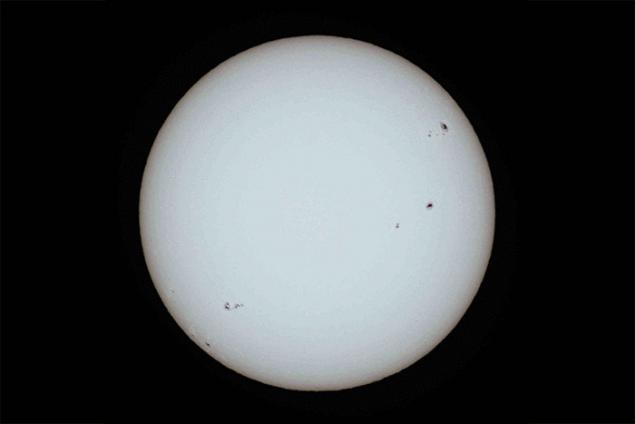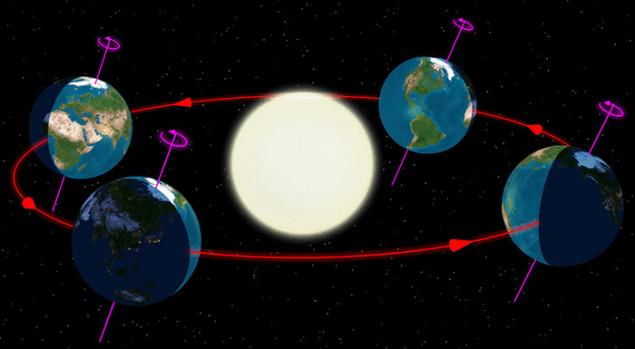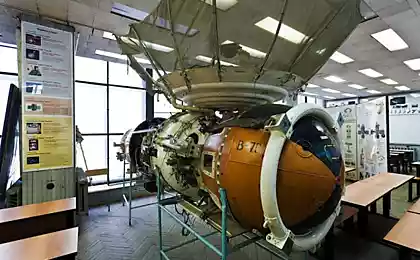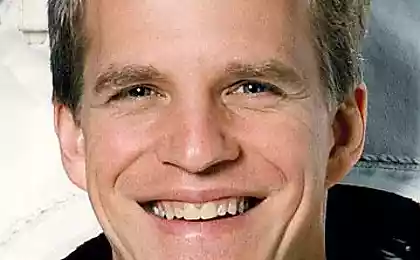626
The universal mystery - 10 myths about space that you need to stop believing
Is it possible to see the Great wall of China from space, whether the moon has a dark side and is it true that the Sun is yellow? This translation of an article designed to debunk 10 common myths about space imposed on us by popular culture and Hollywood.

We explode in space Like many of the myths that believe this idea was practically created from scratch by Hollywood. It often happens that filmmakers are not very worried about the authenticity of the facts. They will be willing to represent reality in any proper light, if only to shoot the scene more interesting. From the movie we know the man is to appear in space without a protective suit, he's dead: after a moment he most likely will explode and turn into a fountain of blood and guts (depending on age restrictions).

The EVAs without the proper equipment definitely will kill you but not instantly and not twisting inside. People can stay in space for about a minute. It's not very nice, but on the other hand, it is not instant death. Most likely, you will die from suffocation for lack of oxygen. A movie that shows it correctly — "Space Odyssey 2001" by Stanley Kubrick.

Venus and Earth are identical Venus is often referred to as our twin but this does not mean that it is the same as Earth. This idea appeared when we had no idea how it looks like the surface of the planet. Because of its incredibly dense atmosphere we could not understand before sent an aircraft that has discovered how really unfriendly and barren surface of Venus.


The sun is a ball of fire In the Sun is glowing, not burning. The average person won't see this as any significant difference, but the heat output of the Sun, is the result of a nuclear reaction, not chemical (combustion — a chemical reaction).

The sun is yellow , Ask anyone to draw the Sun and it will immediately take on a yellow pencil. It is considered normal. We painted the Sun yellow pencil from childhood, when all we can draw is a poor house and a smiling sun in the corner of the sheet. If we need more evidence — well, we can go outside, watch the Sun and make sure that it is yellow.
However, the Sun we see only yellow because of our atmosphere. If you are convinced that you have seen pictures of the Sun NASA, the Sun on them was yellow — well, maybe you're right. Our view of the Sun is yellow so prevalent that sometimes astronomers are editing the colors of the photos so that they were recognizable.
Anyway, the real color of Sun is white. If you ever meet an astronaut or somebody that was in space, ask him about it certainly.

Despite this, we don't have to see the Sun to tell what color it is: we can find out the temperature. Cool stars — brown/tmno red color, the color becomes richer as soon as they heat up. The temperature of the red star — a few thousand degrees Kelvin. At the other end of the spectrum, the hottest stars, their temperature is of the order of ten thousand Kelvin, and the color blue. The temperature of the Sun is about six thousand Kelvin, is somewhere in the middle of the spectrum, which makes it white.

The earth is closer to the sun in summer At first glance this statement seems quite logical. Our planet as it is heated when it's closest to the heat source. Anyway, this idea appeared because of misunderstandings of what the change of seasons. This is not the location relative to the Sun, it is the slope of our orbital axis. The axis around which revolves our planet, heeled to one side. When this axis is tilted towards the Sun, the hemisphere that points to the Sun, summer. When it "looks" to the other side, it is winter.

But the fact that the Earth is sometimes closer and sometimes farther to the Sun, is not a myth. Our planet moves in an orbit having the shape of an ellipse (and most other planets). The distance from Earth to Sun — approximately 150 million kilometers. Despite this, at perihelion (perihelion — closest to Sun point on the Ground), this distance is reduced to 147 million kilometers, and in abelii (largest distance) is increased to 152 million. So during the annual cycle the distance between the Earth and the Sun varies by about five million kilometers.

The moon has a dark side to the Idea that the moon has a face, constantly residing in the shadows, wrong. The moon rotates synchronously with the Earth, and this means that one and the same side facing in our direction and not towards the Sun. All sides of the moon constantly receive sunlight at different points.


Sound in space In movies occasionally hear the sound in space. I think if you had the chance to shoot an explosion or a dramatic death, you will want to audience to hear this. But in space, no atmosphere, and therefore, there is nothing that could pass the sound wave. And again, Kubrick all showed correctly in the "Space Odyssey".
This does not mean that nowhere in the Universe there sounds, once on our planet. If you get to a place where there is atmosphere, there will be sound but perhaps a little strange. On Mars, for example, the sound will be higher.

You can't fly through the asteroid belt we all learned from Star wars. Han Solo showed that he's a badass pilot when he sent the Millennium Falcon through a deadly asteroid belt and reappeared on the other hand, contrary to almost zero the chances of survival. Impressive — if not to take into account the fact that you will probably be able to repeat it, if you have a convenient space ship.
One of those parts, which filmmakers usually get confused when it comes to space — accurate transfer of sizes. It's not their fault if they showed everything in its true size, we could just see a black screen with the little dots here and there (planets or other space objects). Space — very, very, very big. Even if the asteroid belt consists of millions of asteroids, you need to be the biggest loser in the Universe to hurt one of them. It's not impossible, but the chances are minimal.

Take, for example, our own asteroid belt as an example. It contains millions of objects. The largest — Ceres, the former asteroid, now reclassified a dwarf planet. It has about 950 kilometers in diameter. The distance between two objects in the asteroid belt — from hundreds to thousands of kilometers. The chance to hurt one of them is 1:1000000000. We have already sent 11 probes through the asteroid belt — as you may know, without accidents.

The great wall of China is visible from space the Answer is no. This "fact" I read on the Internet already seems to know everything. It is strange that it is still listed among the reliable facts.


NASA receives nearly a quarter of the state budget of course, the U.S. more than anyone else, spent on space research, but, unfortunately, these expenses have been relatively minor in recent years because NASA is gradually losing public support. More and more people less interested in space, and this, of course, a nightmare, because space exploration is one of the most ambitious and important companies in the history of mankind.
One of the most important issues that have NASA, the public opinion, according to which the organization spends too much money. People overestimate the amount of funding that NASA receives annually. Polls regularly show that the average resident of the United States believe that the Agency gets a sizable chunk of the Federal budget, sometimes 25%. And because many now have to fight for survival (in an economic sense), the space program is clearly not something that interests them.
But the fact that NASA is not getting even close to that kind of money. Here is a detailed display of the 2015 budget, it can be seen that the amount that will be received by the organization, is about 0.5%. In fact, for almost the entire lifetime of NASA, their budget was always within one percent. Most of all they've got during the space race in the 60-ies of the last century (4.4 per cent). And never — 25%, of which some are so fond to mention.
Source: theoryandpractice.ru

We explode in space Like many of the myths that believe this idea was practically created from scratch by Hollywood. It often happens that filmmakers are not very worried about the authenticity of the facts. They will be willing to represent reality in any proper light, if only to shoot the scene more interesting. From the movie we know the man is to appear in space without a protective suit, he's dead: after a moment he most likely will explode and turn into a fountain of blood and guts (depending on age restrictions).

The EVAs without the proper equipment definitely will kill you but not instantly and not twisting inside. People can stay in space for about a minute. It's not very nice, but on the other hand, it is not instant death. Most likely, you will die from suffocation for lack of oxygen. A movie that shows it correctly — "Space Odyssey 2001" by Stanley Kubrick.

Venus and Earth are identical Venus is often referred to as our twin but this does not mean that it is the same as Earth. This idea appeared when we had no idea how it looks like the surface of the planet. Because of its incredibly dense atmosphere we could not understand before sent an aircraft that has discovered how really unfriendly and barren surface of Venus.


The sun is a ball of fire In the Sun is glowing, not burning. The average person won't see this as any significant difference, but the heat output of the Sun, is the result of a nuclear reaction, not chemical (combustion — a chemical reaction).

The sun is yellow , Ask anyone to draw the Sun and it will immediately take on a yellow pencil. It is considered normal. We painted the Sun yellow pencil from childhood, when all we can draw is a poor house and a smiling sun in the corner of the sheet. If we need more evidence — well, we can go outside, watch the Sun and make sure that it is yellow.
However, the Sun we see only yellow because of our atmosphere. If you are convinced that you have seen pictures of the Sun NASA, the Sun on them was yellow — well, maybe you're right. Our view of the Sun is yellow so prevalent that sometimes astronomers are editing the colors of the photos so that they were recognizable.
Anyway, the real color of Sun is white. If you ever meet an astronaut or somebody that was in space, ask him about it certainly.

Despite this, we don't have to see the Sun to tell what color it is: we can find out the temperature. Cool stars — brown/tmno red color, the color becomes richer as soon as they heat up. The temperature of the red star — a few thousand degrees Kelvin. At the other end of the spectrum, the hottest stars, their temperature is of the order of ten thousand Kelvin, and the color blue. The temperature of the Sun is about six thousand Kelvin, is somewhere in the middle of the spectrum, which makes it white.

The earth is closer to the sun in summer At first glance this statement seems quite logical. Our planet as it is heated when it's closest to the heat source. Anyway, this idea appeared because of misunderstandings of what the change of seasons. This is not the location relative to the Sun, it is the slope of our orbital axis. The axis around which revolves our planet, heeled to one side. When this axis is tilted towards the Sun, the hemisphere that points to the Sun, summer. When it "looks" to the other side, it is winter.

But the fact that the Earth is sometimes closer and sometimes farther to the Sun, is not a myth. Our planet moves in an orbit having the shape of an ellipse (and most other planets). The distance from Earth to Sun — approximately 150 million kilometers. Despite this, at perihelion (perihelion — closest to Sun point on the Ground), this distance is reduced to 147 million kilometers, and in abelii (largest distance) is increased to 152 million. So during the annual cycle the distance between the Earth and the Sun varies by about five million kilometers.

The moon has a dark side to the Idea that the moon has a face, constantly residing in the shadows, wrong. The moon rotates synchronously with the Earth, and this means that one and the same side facing in our direction and not towards the Sun. All sides of the moon constantly receive sunlight at different points.


Sound in space In movies occasionally hear the sound in space. I think if you had the chance to shoot an explosion or a dramatic death, you will want to audience to hear this. But in space, no atmosphere, and therefore, there is nothing that could pass the sound wave. And again, Kubrick all showed correctly in the "Space Odyssey".
This does not mean that nowhere in the Universe there sounds, once on our planet. If you get to a place where there is atmosphere, there will be sound but perhaps a little strange. On Mars, for example, the sound will be higher.

You can't fly through the asteroid belt we all learned from Star wars. Han Solo showed that he's a badass pilot when he sent the Millennium Falcon through a deadly asteroid belt and reappeared on the other hand, contrary to almost zero the chances of survival. Impressive — if not to take into account the fact that you will probably be able to repeat it, if you have a convenient space ship.
One of those parts, which filmmakers usually get confused when it comes to space — accurate transfer of sizes. It's not their fault if they showed everything in its true size, we could just see a black screen with the little dots here and there (planets or other space objects). Space — very, very, very big. Even if the asteroid belt consists of millions of asteroids, you need to be the biggest loser in the Universe to hurt one of them. It's not impossible, but the chances are minimal.

Take, for example, our own asteroid belt as an example. It contains millions of objects. The largest — Ceres, the former asteroid, now reclassified a dwarf planet. It has about 950 kilometers in diameter. The distance between two objects in the asteroid belt — from hundreds to thousands of kilometers. The chance to hurt one of them is 1:1000000000. We have already sent 11 probes through the asteroid belt — as you may know, without accidents.

The great wall of China is visible from space the Answer is no. This "fact" I read on the Internet already seems to know everything. It is strange that it is still listed among the reliable facts.


NASA receives nearly a quarter of the state budget of course, the U.S. more than anyone else, spent on space research, but, unfortunately, these expenses have been relatively minor in recent years because NASA is gradually losing public support. More and more people less interested in space, and this, of course, a nightmare, because space exploration is one of the most ambitious and important companies in the history of mankind.
One of the most important issues that have NASA, the public opinion, according to which the organization spends too much money. People overestimate the amount of funding that NASA receives annually. Polls regularly show that the average resident of the United States believe that the Agency gets a sizable chunk of the Federal budget, sometimes 25%. And because many now have to fight for survival (in an economic sense), the space program is clearly not something that interests them.
But the fact that NASA is not getting even close to that kind of money. Here is a detailed display of the 2015 budget, it can be seen that the amount that will be received by the organization, is about 0.5%. In fact, for almost the entire lifetime of NASA, their budget was always within one percent. Most of all they've got during the space race in the 60-ies of the last century (4.4 per cent). And never — 25%, of which some are so fond to mention.
Source: theoryandpractice.ru























